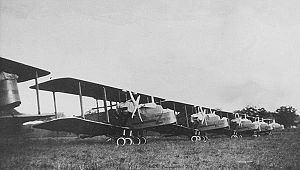Top speed 176 km/h Length 18 m Retired 1933 Manufacturer Handley Page | Wingspan 23 m Introduced 1925 First flight October 23, 1923 | |
 | ||
The Handley Page H.P.24 Hyderabad was a British twin-engine biplane heavy bomber built by Handley Page which served with the Royal Air Force between 1925 and 1933. It was the last wooden heavy bomber to serve with the RAF.
Contents
Design and development
The Hyderabad was a development of the Handley Page W.8 airliner, initially designated the W.8D, to meet Air Ministry Specification 31/22 for a replacement for the Vickers Vimy for the Royal Air Force.
The Hyderabad was structurally similar to the W.8, and was an all-wooden, three-bay biplane powered by two Napier Lion engines. It was fitted with a single fin and rudder, and was one of the first large aircraft to be fitted with Handley Page leading edge slats, giving good lateral stability.
A single prototype W.8D was ordered by the Air Ministry in January 1923, first flying in October 1923 and was delivered to the Aeroplane and Armament Experimental Establishment (A & AEE) at Martlesham Heath for evaluation against the Vickers Virginia. On the basis of this evaluation, the aircraft, now called the Hyderabad was ordered for use by the RAF.
Operational history
The Hyderabad entered service with No. 99 (Bomber) Squadron RAF at RAF Bircham Newton in December 1925, replacing the single-engined Avro Aldershot bomber. Deliveries were slow, and accidental losses were high, with a second squadron, No. 10 Squadron RAF at RAF Upper Heyford only forming in 1928. In 1928 and 1929, two Special Reserve squadrons were formed, receiving the Hyderabad as equipment. The two regular squadrons were re-equipped with the Handley Page Hinaidi, an all-metal development of the Hyderabad in 1931, while the final reserve Squadron, No 503, continued with the Hyderabad in service until 1933.
Operators
Specifications (Hyderabad)
Data from The British Bomber since 1914
General characteristics
Performance
Armament
